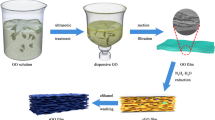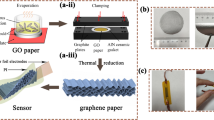Abstract
Wearable pressure sensors have drawn significant attention because of their extensive applications in motion detection, tactile sensing, and health monitoring. However, the complex manufacturing process and high cost of active materials make low-cost, large-scale production elusive. In this work, we report a flexible piezoresistive pressure sensor assembled with two 3D laser-induced graphene (LIG) foam electrodes on a polyimide thin film from a simple laser scribing process in the ambient environment. The design of the air gap between the two foam electrodes allows the sensor to showcase a low limit of detection of 0.274 Pa, which provides favorable sensing performance in motion detection and wrist pulse monitoring. The addition of spherical MoS2 nanoparticles between the two foam electrodes further enhances the sensitivity to 88 kPa−1 and increases the sensing range to significantly outperform the previous literature reports. The demonstrated LIG pressure sensors also exhibit fast response/recovery rates and excellent durability/repeatability.
Similar content being viewed by others
References
Trung T Q, Dang T M L, Ramasundaram S, et al. A stretchable strain-insensitive temperature sensor based on free-standing elastomeric composite fibers for on-body monitoring of skin temperature. ACS Appl Mater Interfaces, 2019, 11: 2317–2327
Yin B, Liu X, Gao H, et al. Bioinspired and bristled microparticles for ultrasensitive pressure and strain sensors. Nat Commun, 2018, 9: 5161
Zhao Y, Zhai Q, Dong D, et al. Highly stretchable and strain-insensitive fiber-based wearable electrochemical biosensor to monitor glucose in the sweat. Anal Chem, 2019, 91: 6569–6576
Tao L Q, Zhang K N, Tian H, et al. Graphene-paper pressure sensor for detecting human motions. ACS Nano, 2017, 11: 8790–8795
Miao P, Wang J, Zhang C, et al. Graphene nanostructure-based tactile sensors for electronic skin applications. Nano-Micro Lett, 2019, 11: 1–37
Jeon G J, Yeom H I, Jin T, et al. A highly sensitive, stable, scalable pressure sensor based on a facile baking-inspired foaming process for a human-computer interface. J Mater Chem C, 2020, 8: 4271–4278
Lou Z, Chen S, Wang L, et al. An ultra-sensitive and rapid response speed graphene pressure sensors for electronic skin and health monitoring. Nano Energy, 2016, 23: 7–14
Han Z, Cheng Z, Chen Y, et al. Fabrication of highly pressure-sensitive, hydrophobic, and flexible 3D carbon nanofiber networks by electrospinning for human physiological signal monitoring. Nanoscale, 2019, 11: 5942–5950
Zhu B, Ling Y, Yap L W, et al. Hierarchically structured vertical gold nanowire array-based wearable pressure sensors for wireless health monitoring. ACS Appl Mater Interfaces, 2019, 11: 29014–29021
Kim S, Amjadi M, Lee T I, et al. Wearable, ultrawide-range, and bending-insensitive pressure sensor based on carbon nanotube network-coated porous elastomer sponges for human interface and healthcare devices. ACS Appl Mater Interfaces, 2019, 11: 23639–23648
Yu G H, Hu J D, Tan J P, et al. A wearable pressure sensor based on ultra-violet/ozone microstructured carbon nanotube/polydimethylsiloxane arrays for electronic skins. Nanotechnology, 2018, 29: 115502
Pang Y, Zhang K, Yang Z, et al. Epidermis microstructure inspired graphene pressure sensor with random distributed spinosum for high sensitivity and large linearity. ACS Nano, 2018, 12: 2346–2354
Han Z, Li H, Xiao J, et al. Ultralow-cost, highly sensitive, and flexible pressure sensors based on carbon black and airlaid paper for wearable electronics. ACS Appl Mater Interfaces, 2019, 11: 33370–33379
Yang J, Luo S, Zhou X, et al. Flexible, tunable, and ultrasensitive capacitive pressure sensor with microconformal graphene electrodes. ACS Appl Mater Interfaces, 2019, 11: 14997–15006
Yang Y, Pan H, Xie G, et al. Flexible piezoelectric pressure sensor based on polydopamine-modified BaTiO3/PVDF composite film for human motion monitoring. Sens Actuat A-Phys, 2020, 301: 111789
Das P S, Chhetry A, Maharjan P, et al. A laser ablated graphene-based flexible self-powered pressure sensor for human gestures and finger pulse monitoring. Nano Res, 2019, 12: 1789–1795
Park S J, Kim J, Chu M, et al. Flexible piezoresistive pressure sensor using wrinkled carbon nanotube thin films for human physiological signals. Adv Mater Technol, 2018, 3: 1700158
Ruth S R A, Feig V R, Tran H, et al. Microengineering pressure sensor active layers for improved performance. Adv Funct Mater, 2020, 30: 2003491
Huang Z, Gao M, Yan Z, et al. Pyramid microstructure with single walled carbon nanotubes for flexible and transparent micro-pressure sensor with ultra-high sensitivity. Sens Actuat A-Phys, 2017, 266: 345–351
Li H, Wu K, Xu Z, et al. Ultrahigh-sensitivity piezoresistive pressure sensors for detection of tiny pressure. ACS Appl Mater Interfaces, 2018, 10: 20826–20834
Peng S, Blanloeuil P, Wu S, et al. Rational design of ultrasensitive pressure sensors by tailoring microscopic features. Adv Mater Interfaces, 2018, 5: 1800403
Li G, Chen D, Li C, et al. Engineered microstructure derived hierarchical deformation of flexible pressure sensor induces a supersensitive piezoresistive property in broad pressure range. Adv Sci, 2020, 7: 2000154
Cheng L, Qian W, Wei L, et al. A highly sensitive piezoresistive sensor with interlocked graphene microarrays for meticulous monitoring of human motions. J Mater Chem C, 2020, 8: 11525–11531
Liu W, Liu N, Yue Y, et al. Piezoresistive pressure sensor based on synergistical innerconnect polyvinyl alcohol nanowires/wrinkled graphene film. Small, 2018, 14: 1704149
Yang J C, Kim J O, Oh J, et al. Microstructured porous pyramid-based ultrahigh sensitive pressure sensor insensitive to strain and temperature. ACS Appl Mater Interfaces, 2019, 11: 19472–19480
Xu X, Wang R, Nie P et al. Copper nanowire-based aerogel with tunable pore structure and its application as flexible pressure sensor. ACS Appl Mater Interfaces, 2017, 9: 14273–14280
Lee D, Lee H, Jeong Y, et al. Highly sensitive, transparent, and durable pressure sensors based on sea-urchin shaped metal nanoparticles. Adv Mater, 2016, 28: 9364–9369
Lin J, Peng Z W, Liu Y Y, et al. Laser-induced porous graphene films from commercial polymers. Nat Commun, 2014, 5: 5714
Ye R, James D K, Tour J M. Laser-induced graphene: From discovery to translation. Adv Mater, 2019, 31: 1803621
Zhang C, Peng Z, Huang C, et al. High-energy all-in-one stretchable micro-supercapacitor arrays based on 3D laser-induced graphene foams decorate with mesoporous ZnP nanosheets for self-powered stretchable systems. Nano Energy, 2021, 81: 105609
Yang L, Yi N, Zhu J, et al. Novel gas sensing platform based on a stretchable laser-induced graphene pattern with self-heating capabilities. J Mater Chem A, 2020, 8: 6487–6500
Zhu J, Hu Z, Song C, et al. Stretchable wideband dipole antennas and rectennas for RF energy harvesting. Mater Today Phys, 2021, 18: 100377
Wakabayashi S, Arie T, Akita S, et al. Very thin, macroscale, flexible, tactile pressure sensor sheet. ACS Omega, 2020, 5: 17721–17725
Tian Q, Yan W, Li Y, et al. Bean pod-inspired ultrasensitive and self-healing pressure sensor based on laser-induced graphene and polystyrene microsphere sandwiched structure. ACS Appl Mater Interfaces, 2020, 12: 9710–9717
Tian H, Shu Y, Wang X F, et al. A graphene-based resistive pressure sensor with record-high sensitivity in a wide pressure range. Sci Rep, 2015, 5: 8603
Zhu Y, Li J, Cai H, et al. Highly sensitive and skin-like pressure sensor based on asymmetric double-layered structures of reduced graphite oxide. Sens Actuat B-Chem, 2018, 255: 1262–1267
Zhu Y S, Cai H B, Ding H Y, et al. Fabrication of low-cost and highly sensitive graphene-based pressure sensors by direct laser scribing polydimethylsiloxane. ACS Appl Mater Interfaces, 2019, 11: 6195–6200
Luo Y, Shao J, Chen S, et al. Flexible capacitive pressure sensor enhanced by tilted micropillar arrays. ACS Appl Mater Interfaces, 2019, 11: 17796–17803
Han S, Liu C, Huang Z, et al. High-performance pressure sensors based on 3d microstructure fabricated by a facile transfer technology. Adv Mater Technol, 2019, 4: 1800640
Yi N, Cheng Z, Li H, et al. Stretchable, ultrasensitive, and low-temperature NO2 sensors based on MoS2@rGO nanocomposites. Mater Today Phys, 2020, 15: 100265
Huang C B, Witomska S, Aliprandi A, et al. Molecule-graphene hybrid materials with tunable mechanoresponse: Highly sensitive pressure sensors for health monitoring. Adv Mater, 2019, 31: 1804600
Guo S Z, Qiu K, Meng F, et al. 3D printed stretchable tactile sensors. Adv Mater, 2017, 29: 1701218
Yang J, Ye Y, Li X, et al. Flexible, conductive, and highly pressure-sensitive graphene-polyimide foam for pressure sensor application. Compos Sci Tech, 2018, 164: 187–194
Chen Z, Wang Z, Li X, et al. Flexible piezoelectric-induced pressure sensors for static measurements based on nanowires/graphene heterostructures. ACS Nano, 2017, 11: 4507–4513
Munir S, Jiang B, Guilcher A, et al. Exercise reduces arterial pressure augmentation through vasodilation of muscular arteries in humans. Am J Physiol-Heart Circulatory Physiol, 2008, 294: H1645–H1650
Chen C H, Ting C T, Nussbacher A, et al. Validation of carotid artery tonometry as a means of estimating augmentation index of ascending aortic pressure. Hypertension, 1996, 27: 168–175
Joo Y, Byun J, Seong N, et al. Silver nanowire-embedded PDMS with a multiscale structure for a highly sensitive and robust flexible pressure sensor. Nanoscale, 2015, 7: 6208–6215
Shuai X, Zhu P, Zeng W, et al. Highly sensitive flexible pressure sensor based on silver nanowires-embedded polydimethylsiloxane electrode with microarray structure. ACS Appl Mater Interfaces, 2017, 9: 26314–26324
Yin F, Yang J, Peng H, et al. Flexible and highly sensitive artificial electronic skin based on graphene/polyamide interlocking fabric. J Mater Chem C, 2018, 6: 6840–6846
Chen W, Gui X, Liang B, et al. Structural engineering for high sensitivity, ultrathin pressure sensors based on wrinkled graphene and anodic aluminum oxide membrane. ACS Appl Mater Interfaces, 2017, 9: 24111–24117
Ma L, Shuai X, Hu Y, et al. A highly sensitive and flexible capacitive pressure sensor based on a micro-arrayed polydimethylsiloxane dielectric layer. J Mater Chem C, 2018, 6: 13232–13240
Xiong Y, Shen Y, Tian L, et al. A flexible, ultra-highly sensitive and stable capacitive pressure sensor with convex microarrays for motion and health monitoring. Nano Energy, 2020, 70: 104436
Jian M, Xia K, Wang Q, et al. Flexible and highly sensitive pressure sensors based on bionic hierarchical structures. Adv Funct Mater, 2017, 27: 1606066
Liu Y, Tao L Q, Wang D Y, et al. Flexible, highly sensitive pressure sensor with a wide range based on graphene-silk network structure. Appl Phys Lett, 2017, 110: 123508
He Z, Chen W, Liang B, et al. Capacitive pressure sensor with high sensitivity and fast response to dynamic interaction based on graphene and porous nylon networks. ACS Appl Mater Interfaces, 2018, 10: 12816–12823
Shi J, Wang L, Dai Z, et al. Multiscale hierarchical design of a flexible piezoresistive pressure sensor with high sensitivity and wide linearity range. Small, 2018, 14: e1800819
Author information
Authors and Affiliations
Corresponding author
Additional information
YANG RuoXi acknowledges the support from the Joint Doctoral Training Foundation of HEBUT. CHENG HuanYu would like to acknowledge the supports from the National Natural Science Foundation of China (Grant No. ECCS-1933072), the National Heart, Lung, and Blood Institute of the National Institutes of Health (Grant No. R61HL154215), and the Penn State University (Center for Security Research and Education, Center for Biodevices, and College of Engineering Multidisciplinary Seed Grants).
Supporting Information
11431_2021_1899_MOESM1_ESM.pdf
Highly sensitive piezoresistive pressure sensors based on laser-induced graphene with molybdenum disulfide nanoparticles
Rights and permissions
About this article
Cite this article
Hao, D., Yang, R., Yi, N. et al. Highly sensitive piezoresistive pressure sensors based on laser-induced graphene with molybdenum disulfide nanoparticles. Sci. China Technol. Sci. 64, 2408–2414 (2021). https://doi.org/10.1007/s11431-021-1899-9
Received:
Accepted:
Published:
Issue Date:
DOI: https://doi.org/10.1007/s11431-021-1899-9




